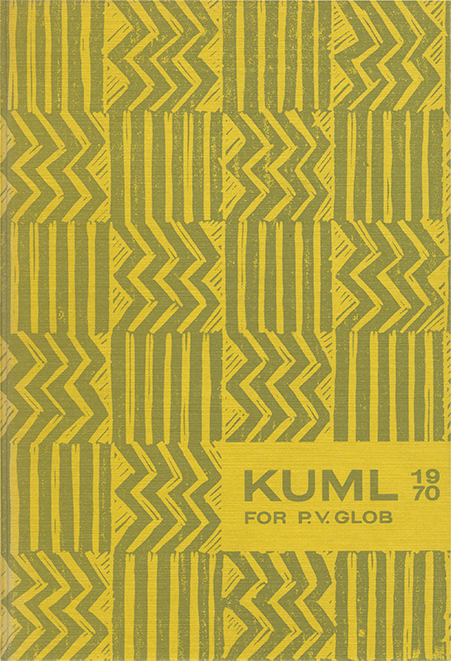Med hevet hånd
DOI:
https://doi.org/10.7146/kuml.v20i20.105424Nøgleord:
petroglyph, billedsten, håndtegn, hand-sign, vestre løkke, norge, Norway, bronzeage, bronzealderResumé
The raised hand
This article is concerned with an unpublished Norwegian petroglyph: a hand-sign of the same type as in fig. 84-93 of P. V. Glob's »Rock Carvings in Denmark«. The stone was discovered in 1966 at the farm of Vestre Løkke in the Skjeberg district of Østfold, in the south-eastern part of Norway. 14 Stones bearing this motif are now known. 12 of these are Danish (Zealand 11, Funen 1) and 2 Norwegian (fig. 3-5) - both from the Skjeberg district. A few of the Danish stones have been found in graves from an early part of the Late Bronze Age, and this dating probably applies to the whole group.
The Vestre Løkke stone (fig. 3-4) was found 30 cm. under the soil surface, but both it and the underlying earth had been removed before the arrival of the archaeologists. According to the finders, the stone covered a cremation grave with black earth containing charcoal and small burnt stones, and this was confirmed by the subsequent investigations on the site. It was, however, not possible to establish whether the grave had contained burnt bones, but in view of the connection of the Danish stones with Bronze Age graves, it is highly probable that the stone from Vestre Løkke had covered a single cremation grave from the Bronze Age. The stone lay picture side up, with the hand pointing east.
The slab has a practically regular quadratic shape and measures 96 x 88 cm., making it the biggest stone of its kind. Its form is undoubtedly natural, since one can see that it has been broken off by ice. The material is granite, with a very smooth and even surface where the picture is.
The engraving consists of 3 figures. The main one is the familiar motif of an arm and band with outstretched fingers. This is accompanied as usual by four horizontal short strokes over the fingers and as a new motif on this kind of stone, by a foot. The engraved lines are only 2-3 mm. deep, but on account of the smooth surface of the stone, nevertheless distinct. The hand-sign is peculiar in that the upper arm and thumb point in different directions, which is physically impossible.
This type of petroglyph has received many interpretations over the years. There is agreement that it must be assigned to the Bronze Age petroglyphs, although the hand with the four transverse strokes (which must clearly be conceived as a single figure) is never found among the rock carvings proper. It is, on the other hand, hardly a coincidence that the Danish stones are found in the central region for the other Bronze Age engravings (cf. figs. 6 and 91 in Glob's publication). This applies, to a lesser extent, to Norway too, as the two stones from Skjeberg stem from the country's richest petroglyphic area.
The circumstances in which the hand-signs are found permit us to regard them as belonging to the Bronze Age petroglyphs but differing from these in their clear connection with grave magic. Whether we have here a »blessing« or a »warning« hand is less certain. Judging by the position of the hand-sign on Danish grave slabs -where it is found both inside and outside the chambers- it seems to have carried both these notions. It seems therefore that the power ascribed to the hand-sign is related to the power expressed on some of the grave-stones of the Viking period where the runes command, »Rest in peace« -an imperative which has had both benedictory and admonitory content. For these reasons I consider our hand-sign to be both beneficient and protective- a sign which could be directed at both the dead and the living. The foot-sign may be interpreted in a similar manner.
The four transverse strokes which always accompany the hand-sign are particularly interesting. They are usually considered to be a symbol, but there is no general agreement as to what they symbolize. In my opinion, the hand-sign may be interpreted in quite another way. The constant repetition of four strokes shows that the number is of principal importance, and since the two strokes in the middle are often longer than the others the sign is probably based on a material prototype. If the object of the strokes were merely to indicate the number 4, it would not be necessary to give them different lengths, and even less so to group them accordingly. I therefore consider the strokes to be a picture of the 4 fingers of a clenched fist. This explains both their position and the system with the two long and two short strokes. It is also an explanation which accords with our conception of the significance of the hand-sign itself. Many people still bang their fists against something to ward off evil, and there is probably a similar notion behind the use of the 4-stroke sign.
Erling JohansenDownloads
Publiceret
Citation/Eksport
Nummer
Sektion
Licens
Fra og med årgang 2022 er artikler udgivet i Kuml med en licens fra Creative Commons (CC BY-NC-SA 4.0).
Alle tidligere årgange af tidsskriftet er ikke udgivet med en licens fra Creative Commons.


